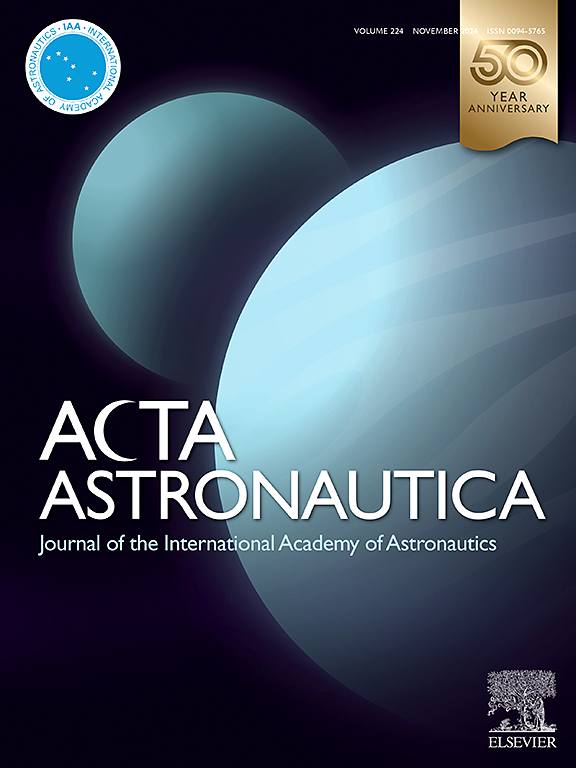Research on the ignition characteristics and discharge performance of LaB6/W composite cathode arcjet thruster
IF 3.1
2区 物理与天体物理
Q1 ENGINEERING, AEROSPACE
引用次数: 0
Abstract
A 200 W class low-power arcjet thruster with a LaB6/W composite cathode has been developed, and a hot-start ignition method has been proposed. This method reduces the ignition voltage to 350 V with a heating power of 90 W, approximately 80 %–90 % lower than the high-frequency or high-voltage ignition methods (several kilovolts). After ignition, the discharge current rises to approximately 25 A within 50 μs, decreases to the operating current after 1–2 ms, oscillating with a fluctuation of ±0.5 A before stabilizing. Meanwhile, the discharge voltage rapidly drops from 350 V to the operating voltage within 100 μs and stabilizes with an oscillation amplitude of ±0.2 V. No transition occurs from low-voltage to high-voltage modes during the hot-start ignition process. Experimental tests using krypton and argon propellants were conducted, showing optimal performance for krypton at 100 W, producing 35.4 ± 0.2 mN of thrust, a specific impulse of 71 ± 2 s, and a thrust efficiency of 8.0 ± 0.3 %. For argon, the optimal parameters were 115 W, producing 26.4 ± 0.2 mN of thrust, a specific impulse of 81 ± 2 s, and a thrust efficiency of 7.0 ± 0.3 %. After 100 ignition cycles and 20 h of operational testing, no erosion was observed on the cathode or anode surfaces. This study demonstrated the advantages of the hot-start ignition method in reducing ignition voltage, alleviating cathode erosion, and enhancing discharge stability.
LaB6/W复合阴极电弧推力器点火特性及放电性能研究
研制了一种采用LaB6/W复合阴极的200w级小功率电弧推力器,并提出了热启动点火方法。该方法将点火电压降低到350v,加热功率为90w,比高频或高压点火方法(几千伏)低约80% - 90%。点火后,放电电流在50 μs内上升到约25 A,在1 ~ 2ms后下降到工作电流,振荡波动为±0.5 A,然后稳定。同时,放电电压在100 μs范围内从350 V迅速下降到工作电压,并稳定下来,振荡幅度为±0.2 V。在热启动点火过程中,不发生从低压模式到高压模式的过渡。采用氪和氩推进剂进行了实验测试,结果表明,氪推进剂在100 W的功率下性能最佳,推力为35.4±0.2 mN,比冲为71±2 s,推力效率为8.0±0.3%。对于氩气,最佳参数为115 W,产生26.4±0.2 mN的推力,比冲为81±2 s,推力效率为7.0±0.3%。经过100次点火循环和20小时的运行测试,阴极和阳极表面未观察到腐蚀。本研究证明了热启动点火方法在降低点火电压、减轻阴极侵蚀、提高放电稳定性等方面的优势。
本文章由计算机程序翻译,如有差异,请以英文原文为准。
求助全文
约1分钟内获得全文
求助全文
来源期刊

Acta Astronautica
工程技术-工程:宇航
CiteScore
7.20
自引率
22.90%
发文量
599
审稿时长
53 days
期刊介绍:
Acta Astronautica is sponsored by the International Academy of Astronautics. Content is based on original contributions in all fields of basic, engineering, life and social space sciences and of space technology related to:
The peaceful scientific exploration of space,
Its exploitation for human welfare and progress,
Conception, design, development and operation of space-borne and Earth-based systems,
In addition to regular issues, the journal publishes selected proceedings of the annual International Astronautical Congress (IAC), transactions of the IAA and special issues on topics of current interest, such as microgravity, space station technology, geostationary orbits, and space economics. Other subject areas include satellite technology, space transportation and communications, space energy, power and propulsion, astrodynamics, extraterrestrial intelligence and Earth observations.
 求助内容:
求助内容: 应助结果提醒方式:
应助结果提醒方式:


